Integrating Child-Friendly Green Spaces into Post-Disaster Recovery: Psychological, Physical, and Educational Sustainability Impact on Children’s Well-Being
Abstract
1. Introduction
2. Materials and Methods
2.1. Search Strategy and Selection Criteria
2.2. Data Analysis and Synthesis
3. Results
3.1. Definitions and Characteristics
3.2. Theoretical Foundations and Practical Outcome
3.3. The Role of Play and Landscape in Post-Disaster Recovery
3.4. Green Space for Children’s Recovery Post-Natural Disaster
- Psychological Impact
- 2.
- Physical Health Benefits
- 3.
- Educational Impact
- 4.
- Multidimensional and Interconnected Recovery
3.5. Quantitative Assessment of CFGS Impact
3.6. Synthesis of Findings
4. Discussion
4.1. Implications
4.2. Barriers to CFGS Integration
4.3. Gaps and Future Directions
5. Conclusions
Author Contributions
Funding
Institutional Review Board Statement
Informed Consent Statement
Data Availability Statement
Conflicts of Interest
References
- Lori, P. Children and disasters: Understanding vulnerability, developing capacities, and promoting resilience. Child. Youth Environ. 2008, 18, 1–29. [Google Scholar] [CrossRef]
- Giordano, F. A qualitative tool for detecting and approaching psychological trauma in children victims of the 2009 Italian earthquake. In Child and Adolescent Mental Health; IntechOpen: London, UK, 2017; pp. 42–57. [Google Scholar]
- UNICEF. 100 Children Killed by Earthquake in West Java, Indonesia. 2022. Available online: https://www.unicef.org/press-releases/100-children-killed-earthquake-west-java-indonesia (accessed on 26 November 2022).
- Moore, R. Chapter Eleven Re-Naturing Urban Childhood: A Sustainable Development Strategy1 Robin Moore, Nilda Cosco. In Forests for Public Health; Cambridge Scholars Publishing: Newcastle upon Tyne, UK, 2020; p. 259. [Google Scholar]
- Sugar, S. The Necessity of Urban Green Space for Children’s Optimal Development. 2021. Available online: https://www.unicef.org/documents/necessity-urban-green-space-childrens-optimal-development (accessed on 25 June 2025).
- Kuo, M. How might contact with nature promote human health? Promising mechanisms and a possible central pathway. Front. Psychol. 2015, 6, 1093. [Google Scholar] [CrossRef]
- Masten, A.S. Resilience of children in disasters: A multisystem perspective. Int. J. Psychol. 2021, 56, 1–11. [Google Scholar] [CrossRef] [PubMed]
- Charlesworth, E.; Fien, J. Design and Disaster Resilience: Toward a Role for Design in Disaster Mitigation and Recovery. Architecture 2022, 2, 292–306. [Google Scholar] [CrossRef]
- Olteanu, A.; Arnberger, R.; Grant, R.; Davis, C.; Abramson, D.; Asola, J. Persistence of mental health needs among children affected by Hurricane Katrina in New Orleans. Prehospital Disaster Med. 2011, 26, 3–6. [Google Scholar] [CrossRef] [PubMed]
- Overstreet, S.; Salloum, A.; Burch, B.; West, J. Challenges Associated with Childhood Exposure to Severe Natural Disasters: Research Review and Clinical Implications. J. Child Adolesc. Trauma 2011, 4, 52–68. [Google Scholar] [CrossRef]
- Hirani, S.A.A.; Richter, S. Maternal and child health during forced displacement. J. Nurs. Scholarsh. 2019, 51, 252–261. [Google Scholar] [CrossRef]
- Fong, K.C.; Hart, J.E.; James, P. A review of epidemiologic studies on greenness and health: Updated literature through 2017. Curr. Environ. Health Rep. 2018, 5, 77–87. [Google Scholar] [CrossRef]
- Dadvand, P.; Nieuwenhuijsen, M.J.; Esnaola, M.; Forns, J.; Basagaña, X.; Alvarez-Pedrerol, M.; Rivas, I.; López-Vicente, M.; De Castro Pascual, M.; Su, J.; et al. Green spaces and cognitive development in primary schoolchildren. Proc. Natl. Acad. Sci. USA 2015, 112, 7937–7942. [Google Scholar] [CrossRef]
- Browning, M.H.; Rigolon, A. School green space and its impact on academic performance: A systematic literature review. Int. J. Environ. Res. Public Health 2019, 16, 429. [Google Scholar] [CrossRef]
- Miller, S. Greenspace After a Disaster: The Need to Close the Gap with Recovery for Greater Resilience. J. Am. Plan. Assoc. 2020, 86, 339–348. [Google Scholar] [CrossRef]
- Ataol, Ö.; Krishnamurthy, S.; van Wesemael, P. Children’s Participation in Urban Planning and Design: A Systematic Review. Child. Youth Environ. 2019, 29, 27–47. [Google Scholar] [CrossRef]
- Kruize, H.; Van Der Vliet, N.; Staatsen, B.; Bell, R.; Chiabai, A.; Muiños, G.; Higgins, S.; Quiroga, S.; Martinez-Juarez, P.; Aberg Yngwe, M.; et al. Urban green space: Creating a triple win for environmental sustainability, health, and health equity through behavior change. Int. J. Environ. Res. Public Health 2019, 16, 4403. [Google Scholar] [CrossRef] [PubMed]
- Vidal, D.G.; Castro Seixas, E. Children’s Green Infrastructure: Children and Their Rights to Nature and the City. Front. Sociol. 2022, 7, 804535. [Google Scholar] [CrossRef] [PubMed]
- Markevych, I.; Schoierer, J.; Hartig, T.; Chudnovsky, A.; Hystad, P.; Dzhambov, A.M.; de Vries, S.; Triguero-Mas, M.; Brauer, M.; Nieuwenhuijsen, M.J.; et al. Exploring pathways linking greenspace to health: Theoretical and methodological guidance. Environ. Res. 2017, 158, 301–317. [Google Scholar] [CrossRef]
- Munn, Z.; Peters, M.D.; Stern, C.; Tufanaru, C.; McArthur, A.; Aromataris, E. Systematic review or scoping review? Guidance for authors when choosing between a systematic or scoping review approach. BMC Med. Res. Methodol. 2018, 18, 143. [Google Scholar] [CrossRef]
- Dadvand, P.; Gascon, M.; Markevych, I. Green spaces and child health and development. In Biodiversity and Health in the Face of Climate Change; Springer International Publishing: Cham, Switzerland, 2019; pp. 121–130. [Google Scholar]
- Schweiger, G.; Graf, G. Ethics and the dynamic vulnerability of children. Les Ateliers de l’Éthique 2017, 12, 243–261. [Google Scholar] [CrossRef]
- Porter, J.E.; Dabkowski, E.; Ghasemirdekani, M.; Barbagallo, M.S.; James, M.H.; Prokopiv, V.; Wright, W. The impact of nature-led recovery initiatives for individual and community health post disaster: A systematic literature review. Rev. Environ. Health 2023, 38, 637–646. [Google Scholar] [CrossRef]
- Flemming, K.; Booth, A.; Garside, R.; Tunçalp, Ö.; Noyes, J. Qualitative evidence synthesis for complex interventions and guideline development: Clarification of the purpose, designs and relevant methods. BMJ Glob. Health 2019, 4 (Suppl. S1), e000882. [Google Scholar] [CrossRef]
- Braun, V.; Clarke, V. Using thematic analysis in psychology. Qual. Res. Psychol. 2006, 3, 77–101. [Google Scholar] [CrossRef]
- Nowell, L.S.; Norris, J.M.; White, D.E.; Moules, N.J. Thematic analysis: Striving to meet the trustworthiness criteria. Int. J. Qual. Methods 2017, 16, 1609406917733847. [Google Scholar] [CrossRef]
- Din, S.K.J.; Russo, A.; Liversedge, J. Designing Healing Environments: A Literature Review on the Benefits of Healing Gardens for Children in Healthcare Facilities and the Urgent Need for Policy Implementation. Land 2023, 12, 971. [Google Scholar] [CrossRef]
- Hussein, H.; Abidin, N.M.N.Z.; Omar, Z. Sensory Gardens: A multidisciplinary effort. Asian J. Behav. Stud. 2016, 1, 32–40. [Google Scholar] [CrossRef]
- Hussein, H. The influence of sensory gardens on the behaviour of children with special educational needs. Procedia-Soc. Behav. Sci. 2012, 38, 343–354. [Google Scholar] [CrossRef]
- Chan, J.; DuBois, B.; Tidball, K.G. Refuges of local resilience: Community gardens in post-Sandy New York City. Urban For. Urban Green. 2015, 14, 625–635. [Google Scholar] [CrossRef]
- Allcock, A. Healing Environments for Children Who Have Experienced Trauma. 2019. Available online: https://www.iriss.org.uk/sites/default/files/2019-04/iriss-esss-outline-healing-environ-children-20190506.pdf (accessed on 25 June 2025).
- Atmodiwirjo, P.; Ghaziani, R.; Wungpatcharapon, S.; Djuwita, R.; Yatmo, Y.A. Nature-Related Features and Children’s Well-Being in Post-Disaster School Design. Int. J. Disaster Resil. Built Environ. 2023, 16, 143–156. [Google Scholar] [CrossRef]
- Jorgensen, A.; Gobster, P.H. Shades of Green: Measuring the Ecology of Urban Green Space in the Context of Human Health and Well-Being. Nat. Cult. 2010, 5, 338–363. [Google Scholar] [CrossRef]
- Bratman, G.N.; Hamilton, J.P.; Hahn, K.S.; Daily, G.C.; Gross, J.J. Nature experience reduces rumination and subgenual prefrontal cortex activation. Proc. Natl. Acad. Sci. USA 2015, 112, 8567–8572. [Google Scholar] [CrossRef]
- Hussein, H. Using the sensory garden as a tool to enhance the educational development and social interaction of children with special needs. Support Learn. 2010, 25, 25–31. [Google Scholar] [CrossRef]
- Hällqvist, K. Exploring Dimensions of Children’s Access to Urban Green Space: A Mixed-Method Analysis of Malmö, Sweden. 2024. Available online: https://www.diva-portal.org/smash/record.jsf?pid=diva2:1865174 (accessed on 25 June 2025).
- Bagot, K.L. Perceived restorative components: A scale for children. Child. Youth Environ. 2004, 14, 107–129. [Google Scholar] [CrossRef]
- Hussein, H. Sensory affordances in outdoor play environment towards well-being of special schooled children. Intell. Build. Int. 2017, 9, 148–163. [Google Scholar] [CrossRef]
- Masten, A.S.; Narayan, A.J. Child development in the context of disaster, war, and terrorism: Pathways of risk and resilience. Annu. Rev. Psychol. 2012, 63, 227–257. [Google Scholar] [CrossRef]
- Mizuki, R.; Kobayashi, T.; Maeda, M. Disruption of Child Environments and Its Psychological Consequences After the Fukushima Disaster: A Narrative Review Based on the Ecological Systems Model. Curr. Psychiatry Rep. 2021, 23, 49. [Google Scholar] [CrossRef] [PubMed]
- Bornioli, A.; Subiza-Pérez, M. Restorative urban environments for healthy cities: A theoretical model for the study of restorative experiences in urban built settings. Landsc. Res. 2023, 48, 152–163. [Google Scholar] [CrossRef]
- Perry, B.D. Creative Interventions with Traumatized Children; Guilford Publications: New York, NY, USA, 2014. [Google Scholar]
- Lester, S.; Maudsley, M. Play, Naturally; National Children’s Bureau/Play England: London, UK, 2007. [Google Scholar]
- Lester, S.; Russell, W. Children’s Right to Play: An Examination of the Importance of Play in the Lives of Children Worldwide; Working Papers in Early Childhood Development, No. 57; ERIC: The Hague, The Netherlands, 2010. [Google Scholar]
- Fjortoft, I. The natural environment as a playground for children: The impact of outdoor play activities in pre-primary school children. Early Child. Educ. J. 2001, 29, 111–117. [Google Scholar] [CrossRef]
- Tovey, H. Playing Outdoors: Spaces and Places, Risk and Challenge; McGraw-Hill Education (UK): Maidenhead, UK, 2007. [Google Scholar]
- Veitch, J.; Salmon, J.; Ball, K. Children’s active free play in local neighborhoods: A behavioral mapping study. Health Educ. Res. 2007, 23, 870–879. [Google Scholar] [CrossRef]
- UNICEF. Two Years After the Earthquake, Victories for Haiti’s Children. 2012. Available online: https://www.unicef.ie/stories/two-years-after-the-earthquake-victories-for-haitis-children/ (accessed on 23 September 2023).
- Lee, R.L.T.; Lane, S.; Brown, G.; Leung, C.; Kwok, S.W.H.; Chan, S.W.C. Systematic review of the impact of unstructured play interventions to improve young children’s physical, social, and emotional wellbeing. Nurs. Health Sci. 2020, 22, 184–196. [Google Scholar] [CrossRef]
- Sheridan, B. The Implications of Climate Change for Children in Lower-Income Countries. Child. Youth Environ. 2008, 18, 71–98. [Google Scholar] [CrossRef]
- Cui, Y.; Wang, Q.; Zha, G.; Dang, Y.; Duan, X.; Wang, L.; Luo, M. Evaluation of the Accessibility of Children’s Spaces at the Community Scale: The Case Study of Hangzhou. ISPRS Int. J. Geo-Inf. 2024, 13, 55. [Google Scholar] [CrossRef]
- Vanaken, G.J.; Danckaerts, M. Impact of green space exposure on children’s and adolescents’ mental health: A systematic review. Int. J. Environ. Res. Public Health 2018, 15, 2668. [Google Scholar] [CrossRef]
- Manandhar, S.; Suksaroj, T.T.; Rattanapan, C. The association between green space and the prevalence of overweight/obesity among primary school children. Int. J. Occup. Environ. Med. 2019, 10, 1–10. [Google Scholar] [CrossRef]
- Engelbrecht, A.; Jobson, L. Exploring trauma associated appraisals in trauma survivors from collectivistic cultures. Springerplus 2016, 5, 1565. [Google Scholar] [CrossRef]
- Veitch, J.; Bagley, S.; Ball, K.; Salmon, J. Where do children usually play? A qualitative study of parents’ perceptions of influences on children’s active free-play. Health Place 2006, 12, 383–393. [Google Scholar] [CrossRef]
- Gibbs, L.; Mutch, C.; O’COnnor, P.; MacDougall, C. Research with, by, for and about children: Lessons from disaster contexts. Glob. Stud. Child. 2013, 3, 129–141. [Google Scholar] [CrossRef]
- Schutte, A.R.; Torquati, J.C.; Beattie, H.L. Impact of urban nature on executive functioning in early and middle childhood. Environ. Behav. 2017, 49, 3–30. [Google Scholar] [CrossRef]
- Walshe, N.; Lee, E.; Smith, M.J. Supporting children’s well-being with art in nature: Artist pedagogue perceptions. J. Educ. Sustain. Dev. 2020, 14, 98–112. [Google Scholar] [CrossRef]
- Moll, A.; Collado, S.; Staats, H.; Corraliza, J.A. Restorative effects of exposure to nature on children and adolescents: A systematic review. J. Environ. Psychol. 2022, 84, 101884. [Google Scholar] [CrossRef]
- Orui, M.; Nakajima, S.; Takebayashi, Y.; Ito, A.; Momoi, M.; Maeda, M.; Yasumura, S.; Ohto, H. Mental health recovery of evacuees and residents from the Fukushima Daiichi Nuclear Power Plant accident after seven years—Contribution of social network and a desirable lifestyle. Int. J. Environ. Res. Public Health 2018, 15, 2381. [Google Scholar] [CrossRef]
- Roemmich, J.N.; Johnson, L.; Oberg, G.; Beeler, J.E.; Ufholz, K.E. Youth and Adult Visitation and Physical Activity Intensity at Rural and Urban Parks. Int. J. Environ. Res. Public Health 2018, 15, 1760. [Google Scholar] [CrossRef]
- Reuben, A.; Rutherford, G.W.; James, J.; Razani, N. Association of Neighborhood Parks with Child Health in the United States. Prev. Med. 2020, 141, 106265. [Google Scholar] [CrossRef]
- Balseviciene, B.; Sinkariova, L.; Grazuleviciene, R.; Andrusaityte, S.; Uzdanaviciute, I.; Dedele, A.; Nieuwenhuijsen, M.J. Impact of residential greenness on preschool children’s emotional and behavioral problems. Int. J. Environ. Res. Public Health 2014, 11, 6757–6770. [Google Scholar] [CrossRef]
- Tillmann, S.; Tobin, D.; Avison, W.; Gilliland, J. Mental health benefits of interactions with nature in children and teenagers: A systematic review. J. Epidemiol. Community Health 2018, 72, 958–966. [Google Scholar] [CrossRef]
- Taylor, A.F.; Kuo, F.E. Children with attention deficits concentrate better after walk in the park. J. Atten. Disord. 2009, 12, 402–409. [Google Scholar] [CrossRef]
- Jenkin, R.; Frampton, I.; White, M.P.; Pahl, S. The relationship between exposure to natural and urban environments and children’s self-regulation. Landsc. Res. 2018, 43, 315–328. [Google Scholar] [CrossRef]
- Dewi, R.I.; Sya, A.; Vivanti, D. Multifunction Green Open Space for Environmental Education. KnE Soc. Sci. 2020, 4, 10–20. [Google Scholar]
- Dost, G. A Critical Review of Environmental Education for Sustainable Development Goals, UNCRC and Child-Friendly Schools. In Proceedings of the European Conference on Education, London, UK, 15–18 July 2021. [Google Scholar]
- Laura Healey, M.; Rosie, P. Reconceptualizing School Design: Learning Environments for Children and Youth. Child. Youth Environ. 2012, 22, 11–22. [Google Scholar] [CrossRef]
- Parameswaran, U.D.; Molloy, J.; Kuttner, P. Healing Schools: A Framework for Joining Trauma-Informed Care, Restorative Justice, and Multicultural Education for Whole School Reform. Urban Rev. 2023, 56, 186–209. [Google Scholar] [CrossRef]
- Zhang, Z.; Stevenson, K.T.; Martin, K.L. Use of nature-based schoolyards predicts students’ perceptions of schoolyards as places to support learning, play, and mental health. Environ. Educ. Res. 2022, 28, 1271–1282. [Google Scholar] [CrossRef]
- Goosen, Z. The Planning and Development of Child-Friendly Green Spaces in Urban South Africa. Agric. For. Fish. 2015, 4, 33. [Google Scholar] [CrossRef][Green Version]
- Tyler, J.; Singh, A. Enhancing post-earthquake disaster resilience. Int. J. Disaster Resil. Built Environ. 2011, 2, 103–117. [Google Scholar] [CrossRef]
- Meerow, S.; Stults, M. Comparing conceptualizations of urban climate resilience in theory and practice. Sustainability 2016, 8, 701. [Google Scholar] [CrossRef]
- Peek, L.; Richardson, K. In their own words: Displaced children’s educational recovery needs after Hurricane Katrina. Disaster Med. Public Health Prep. 2010, 4, S63–S70. [Google Scholar] [CrossRef]
- Hikichi, H.; Aida, J.; Tsuboya, T.; Kondo, K.; Kawachi, I. Can Community Social Cohesion Prevent Posttraumatic Stress Disorder in the Aftermath of a Disaster? A Natural Experiment From the 2011 Tohoku Earthquake and Tsunami. Am. J. Epidemiol. 2016, 183, 902–910. [Google Scholar] [CrossRef] [PubMed]
- Dimouli, I.; Koumparou, D.; Golfínopoulos, S.K. From School Gardens to Community Oases: Fostering Environmental and Social Resilience in Urban Spaces. Geographies 2024, 4, 687–712. [Google Scholar] [CrossRef]
- Eagland, S.; Curtin, M.; Parnell, T. After the Disaster: Facilitating Children to Talk of Their Feeling and Experiences. In International Perspectives on Early Childhood Education and Development; Springer International Publishing: Cham, Switzerland, 2024; pp. 197–208. [Google Scholar]
- Veitch, J.; Flowers, E.; Ball, K.; Deforche, B.; Timperio, A. Exploring children’s views on important park features: A qualitative study using walk-along interviews. Int. J. Environ. Res. Public Health 2020, 17, 4625. [Google Scholar] [CrossRef] [PubMed]
- Peek, L.; Abramson, D.M.; Cox, R.S.; Fothergill, A.; Tobin, J. Children and disasters. In Handbook of Disaster Research; Springer International Publishing: Cham, Switzerland, 2018; pp. 243–262. [Google Scholar]
- Schneider, A.A. An oasis for students: Investigating the potential co-benefits of schoolyard redesign for climate adaptation. In Master Thesis Series in Environmental Studies and Sustainability Science; Lund University Centre for Sustainability Studies: Lund, Sweden, 2020. [Google Scholar]
- Hettige, S.; Haigh, R. An integrated social response to disasters: The case of the Indian Ocean tsunami in Sri Lanka. Disaster Prev. Manag. Int. J. 2016, 25, 595–610. [Google Scholar] [CrossRef]
- Hussein, H. Sensory garden in special schools: The issues, design and use. J. Des. Built Environ. 2009, 5, 77–95. [Google Scholar]
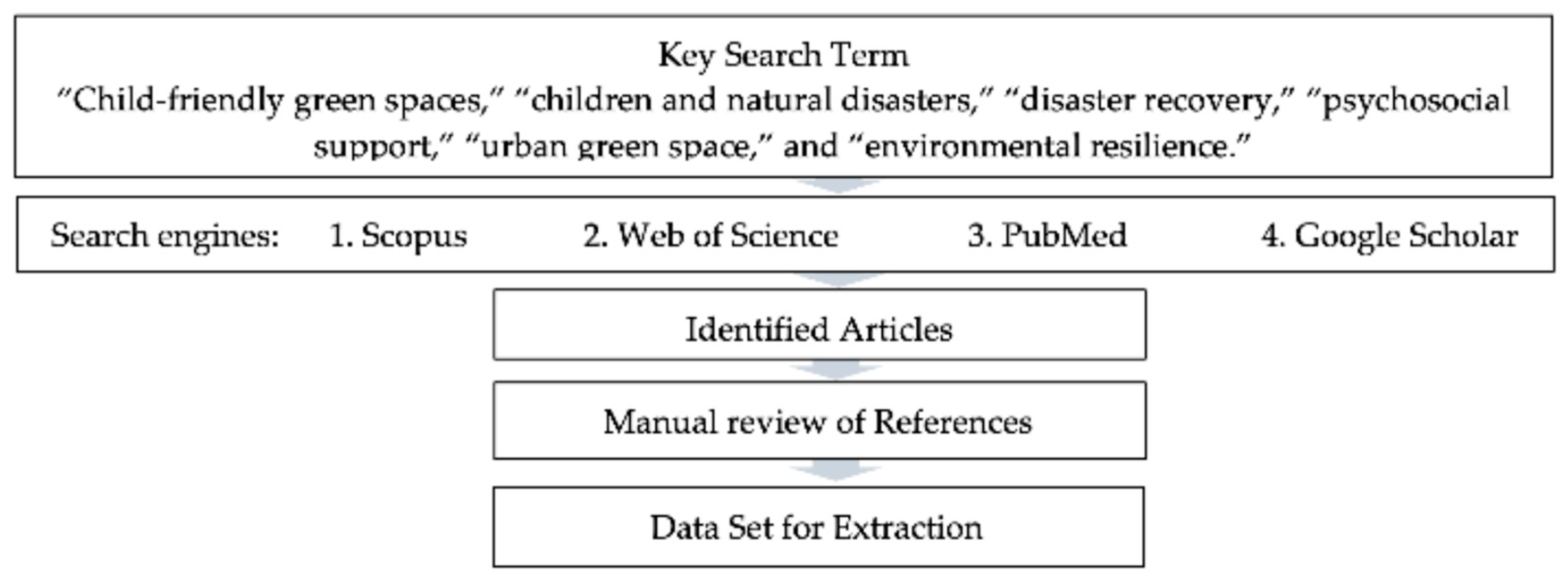
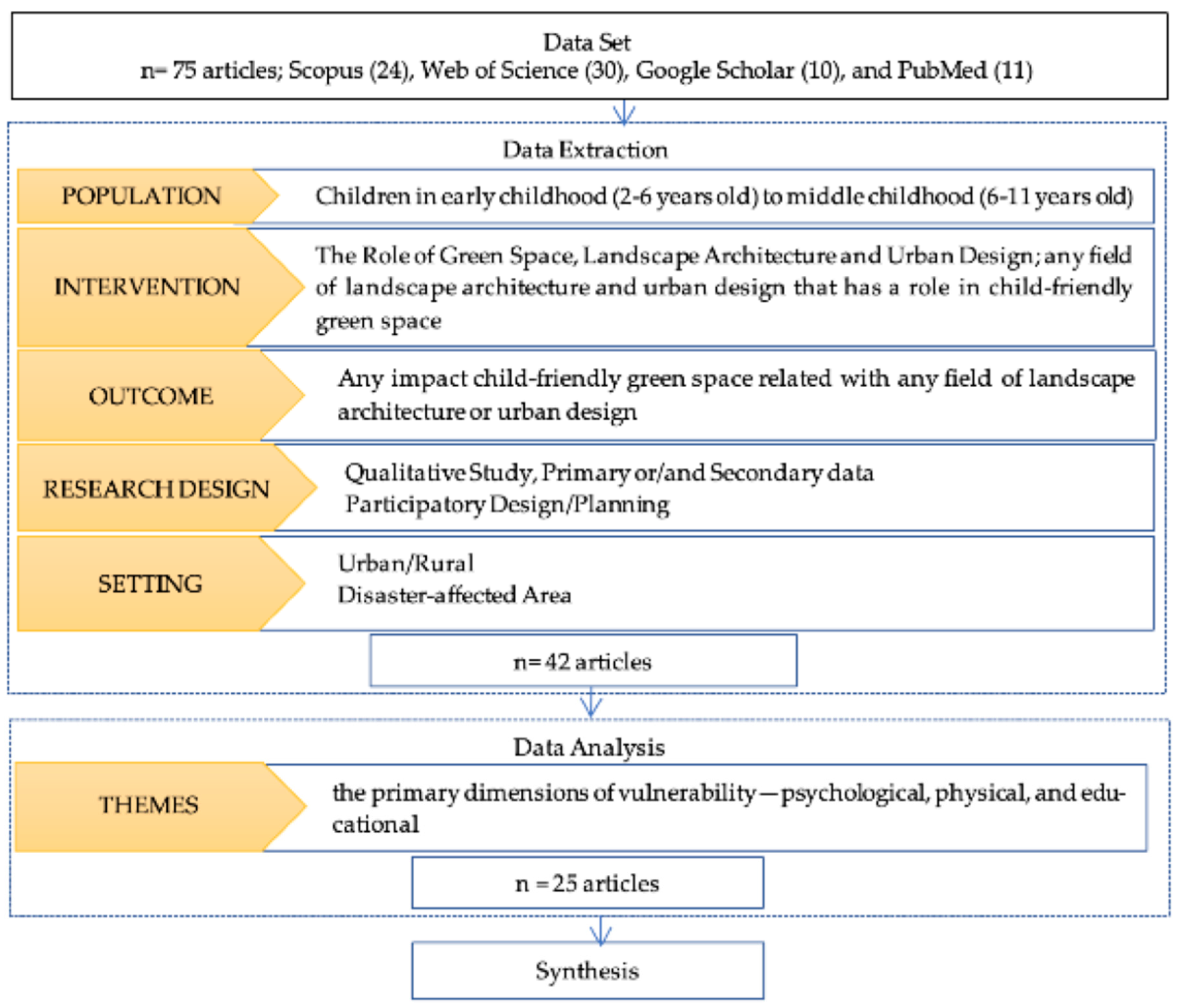

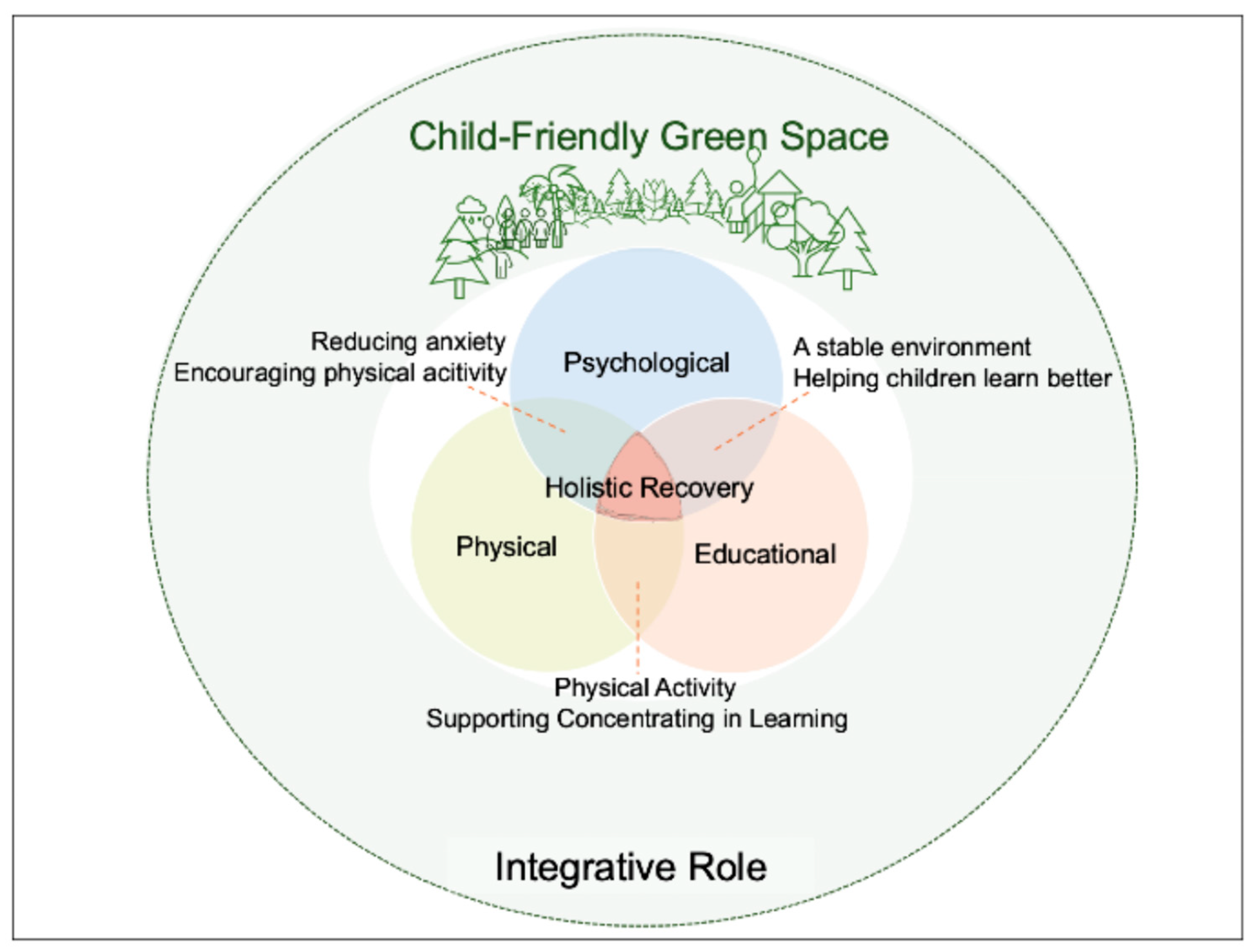
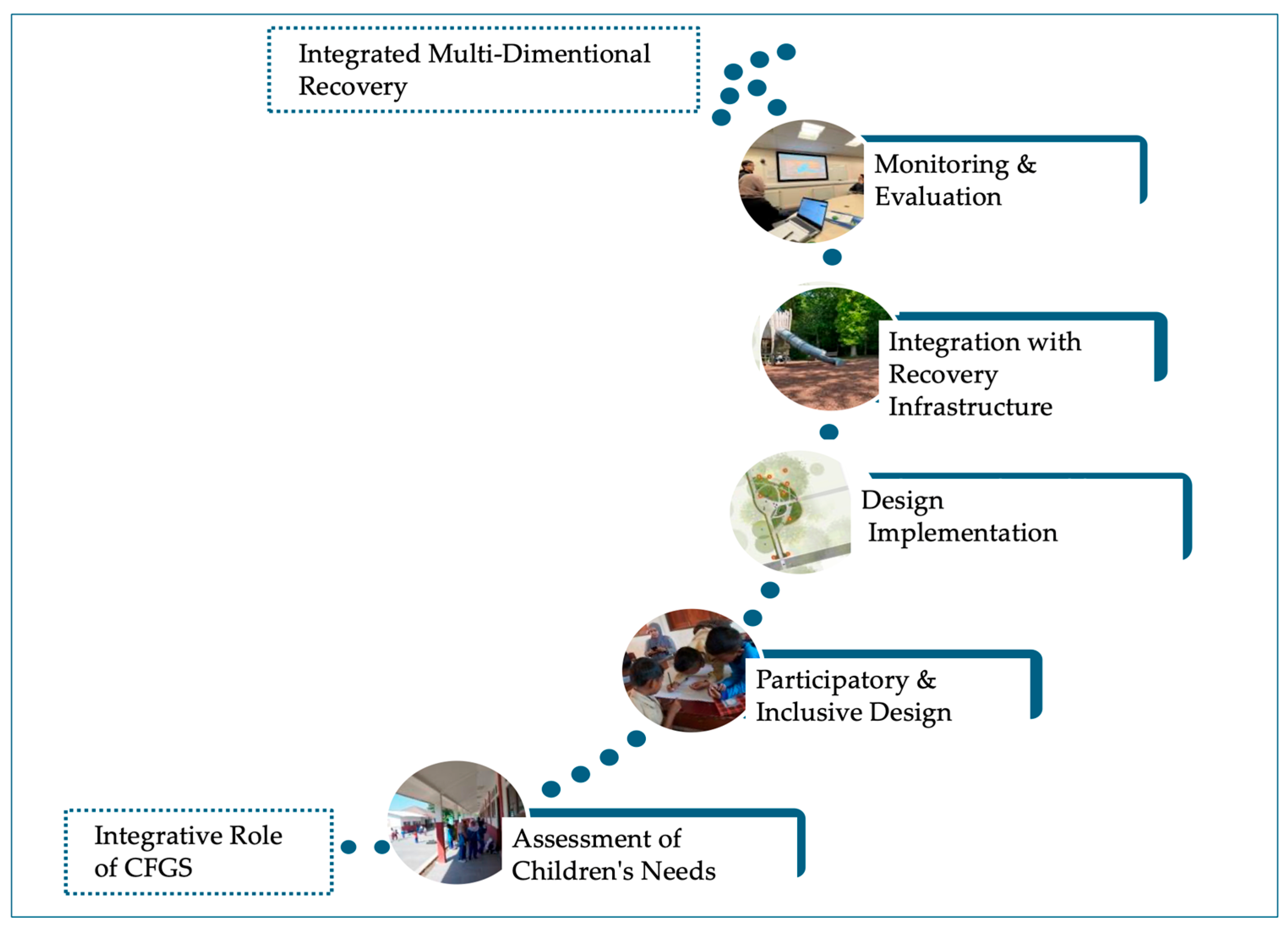
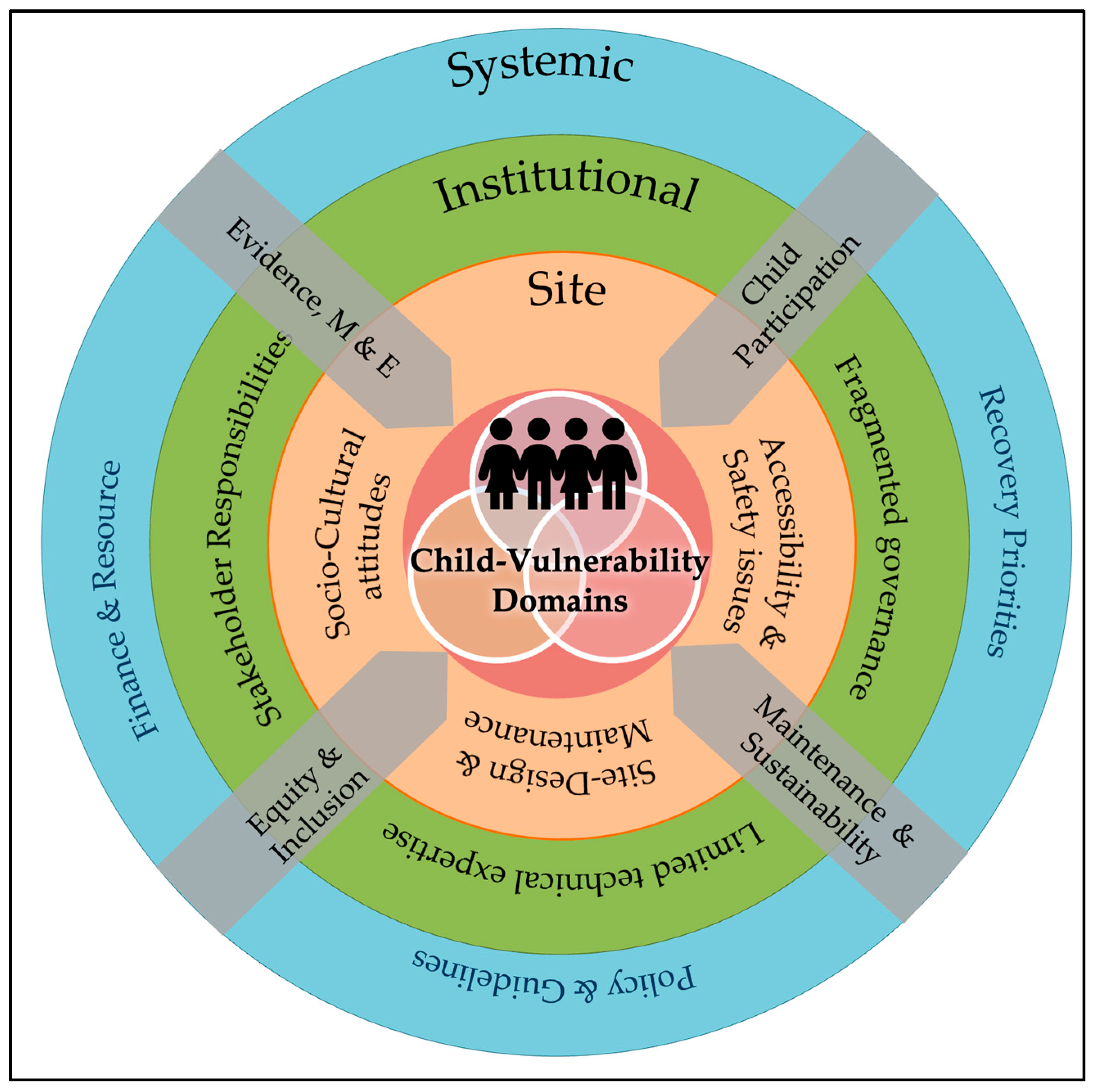
| Characteristic | Key Features | Benefits | References |
|---|---|---|---|
| Accessibility | Within walking distance, inclusive design. Combines structured/unstructured areas. | Reduces health inequalities | [5,28,35,36] |
| Multifunctionality | Diverse experiences and activities tailored to the local cultural and environmental context | Support holistic development (physical, emotional, social, intellectual, and cognitive development) | [18,30,35] |
| Emotional Connection | Foster connection to nature, sense of belonging, and nurtures spiritual growth and empathy. | Encourages positive feelings, comfort, empathy, and resilience in children | [5,10,18,28] |
| Safety | Secure environment; minimized risks; inclusive for children with disabilities | Enables safe exploration and play; increases parental and community trust | [5,33,34] |
| Natural elements | Biodiversity (Variety of plants, trees, water features, wildlife) | Enhances sensory stimulation, supports cognitive restoration, and stewardship of nature | [5,37,38] |
| Community Participation | Involvement of children, family, stakeholders, and local community in the design and maintenance of green space | Ensures spaces meet children’s needs, build community ownership, and promote stewardship | [5,16,28] |
| Domain | Key Points | Descriptions | References |
|---|---|---|---|
| 1. Psychological | Emotional Stability and mental health symptoms reductions | Support emotional well-being, lower trauma-related mental health, and stress reduction after traumatic events. | [9,10,34,52,57,58,59] |
| Healing Environments | Therapeutic design elements reduce stress, improve recovery, and support cognitive healing. | [28,29,31,35] | |
| Structured and Unstructured Play | Positive impacts of structured play within CFGS for trauma processing and stress alleviation. | [10,54] | |
| 2. Physical | Promotion of Physical Activity | Encourage outdoor play, improving physical strength and facilitating physical activity | [11,60,61,62] |
| Overall, Health Improvements | Improved attention, mood, and physical health observed in children spending time in CFGS. | [52,63,64] | |
| Development of Healthy Habits | Encouraging outdoor play contributes to the development of healthy cardiovascular and muscle strength. | [12,51] | |
| 3. Educational | Cognitive Development | Access to CFGS improves concentration and memory retention. | [13,17,65,66] |
| School Attendance and Academic Performance | Correlation between regular access to CFGS and improved attendance/performance. | [14,70] | |
| Informal Learning Environment | Promotion of creativity and exploration, fostering social skills and emotional intelligence. | [47,68,69] | |
| 4.Multidimensional Recovery | Holistic Recovery Tool | CFGS provide overlapping benefits for psychological, physical, and educational recovery. | [40,71] |
| Interconnectedness of Benefits | Encourages multifaceted recovery linked to increased participation in physical, social interaction and academic activities. | [52,72] |
| Action Component | Objective | Key Activity | Outcome and Benefit |
|---|---|---|---|
| Assessment of Children’s Needs | Identify children’s needs based on children’s vulnerability (psychological, physical, and educational). | Conduct surveys, focus groups, and observational studies. | Understand specific needs to tailor CFGS, ensuring effective recovery [1,72,78]. |
| Participatory and Inclusive Design | Co-create solutions involving children, community, and stakeholders. | Workshops, participatory activities, meetings, and discussions. | Foster community involvement and ownership, ensuring relevance, effectiveness, and sustainability [16,28]. |
| Design Implementation | Translate participatory plans into functional, safe, and therapeutic green spaces. | Build multifunctional green spaces, structures/unstructured, and learning environments based on identified needs. | Realize design plans into physical spaces, supporting psychological, physical, and educational recovery [5,28,33,34,37,79]. |
| Integration with Recovery Infrastructure | Align CFGS with broader recovery and policy systems to ensure sustainability. | Collaboration between landscape architects, planners, and stakeholders to embed CFGS into the recovery policies and funding mechanism. | Ensure CFGS are part of a comprehensive recovery strategy, enhancing impact, policy support and sustainability [27,32]. |
| Monitoring and Evaluation | Measure safety, usability, effectiveness, and long-term impact of CFGS. | Conduct follow-up studies, collect feedback, engage the community in stewardship and maintenance, and adjust designs as necessary to improve outcomes. | Refine CFGS through continuous evaluation, increased community ownership, ensuring they meet evolving needs, and maximize long-term benefits [5,16,28,40]. |
| Barrier Level | Barrier Category | Description | Recommendation |
|---|---|---|---|
| Systemic | Policy and Guidelines | Lack of clear policies and mandates for CFGS integration | Develop evidence-based policies; embed CFGS in recovery plans |
| Recovery Priorities | Immediate relief focus overshadows green space funding | Advocate for long-term recovery funding and strategic inclusion | |
| Finance and Resources | Insufficient dedicated funding for development and maintenance | Secure sustainable funding streams for CFGS | |
| Institutional | Fragmented Governance | Lack of coordinated governance and unclear stakeholder roles | Establish clear roles and cross-sector collaboration |
| Stakeholder Responsibilities | Ambiguity in mandates and accountability | Define responsibilities and improve coordination | |
| Limited Technical Expertise | Insufficient expertise in sensory and inclusive design | Build capacity and provide specialized training | |
| Site | Accessibility and Safety | Land scarcity, safety risks limit access | Improve safe, inclusive access and infrastructure |
| Socio-Cultural Attitudes | Cultural mismatch and low community engagement | Employ culturally sensitive participatory design | |
| Site Design and Maintenance | Poor maintenance and lack of community stewardship | Promote community involvement and sustainable maintenance |
| SDG | CFGS Contribution | Key References |
|---|---|---|
| SDG 3: Health and Well-being | Reduces trauma, supports mental and physical health, fosters active lifestyles | [9,17,63] |
| SDG 4: Quality Education | Improves concentration, school attendance, supports informal and experiential learning | [13,14,47] |
| SDG 11: Sustainable Cities | Promotes inclusive, resilient, and participatory urban development; enhances social cohesion | [16,18,74] |
Disclaimer/Publisher’s Note: The statements, opinions and data contained in all publications are solely those of the individual author(s) and contributor(s) and not of MDPI and/or the editor(s). MDPI and/or the editor(s) disclaim responsibility for any injury to people or property resulting from any ideas, methods, instructions or products referred to in the content. |
© 2025 by the authors. Licensee MDPI, Basel, Switzerland. This article is an open access article distributed under the terms and conditions of the Creative Commons Attribution (CC BY) license (https://creativecommons.org/licenses/by/4.0/).
Share and Cite
Anwar, D.R.; Selim, G. Integrating Child-Friendly Green Spaces into Post-Disaster Recovery: Psychological, Physical, and Educational Sustainability Impact on Children’s Well-Being. Sustainability 2025, 17, 8495. https://doi.org/10.3390/su17188495
Anwar DR, Selim G. Integrating Child-Friendly Green Spaces into Post-Disaster Recovery: Psychological, Physical, and Educational Sustainability Impact on Children’s Well-Being. Sustainability. 2025; 17(18):8495. https://doi.org/10.3390/su17188495
Chicago/Turabian StyleAnwar, Dewi Rezalini, and Gehan Selim. 2025. "Integrating Child-Friendly Green Spaces into Post-Disaster Recovery: Psychological, Physical, and Educational Sustainability Impact on Children’s Well-Being" Sustainability 17, no. 18: 8495. https://doi.org/10.3390/su17188495
APA StyleAnwar, D. R., & Selim, G. (2025). Integrating Child-Friendly Green Spaces into Post-Disaster Recovery: Psychological, Physical, and Educational Sustainability Impact on Children’s Well-Being. Sustainability, 17(18), 8495. https://doi.org/10.3390/su17188495








